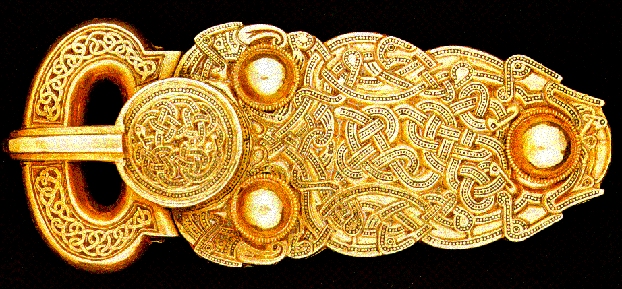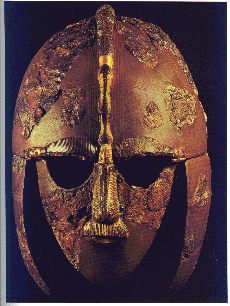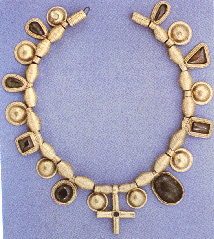|
Comitatus is the basic idea that everyone protects the king at all costs even if it means a warrior giving up his own life. If a king is killed, the warriors must avenge the death of the king or they can no longer serve as warriors for the next king. It is an idea that coexists with the interlacing theme. You will see the comitatus theme all through Beowulf and all of the Anglo-Saxon poetry. The diction (ring-giver, hearth-companion, etc) indicates the idea as well as the behavior. Notice how there is the motif of eating, sleeping, dying all the way through the text, and all of it is done as a "team" even to the passing of the cup uniting the group of warriors. They stayed in the meadhall while the king slept in an adjoining "apartment" so they could constantly protect him. You will even see the idea in the avenging of Grendel's death by his mother. Some of the same actions on her part are the same as the actions of the warriors. Beowulf is also a good text to demonstrate how comitatus died with the Anglo-Saxon period. Notice how at the end of the text only Wiglaf follows Beowulf into the battle with the dragon. When Beowulf goes into the various battles, there is a progression of the comitatus dying with the behavior of the warriors: the warriors stand on the bank waiting, the next time they are sleeping and the third time only Wiglaf goes with him. The comitatus idea goes hand in hand with interlacing. Interlacing is best seen in the artwork of the period and then transferred into the text. You have probably seen a picture of the chalice or the necklace or even the helmet most closely associated with Beowulf. The interlacing is difficult to see on the helmet, but it is in the ridge across the top. The design is actually that of a flying dragon-like creature. The wings go across the top of the eyes like eyebrows, the head is at the nose piece and the body, twists across the head to the back of the helmet. The reason for the ridges across the helmets was to deflect a blow from a sword. It was a great illustration of the strength found in interlacing used to protect the individual.  The Belt Buckle from the Sutton Hoo treasures shows the interlacing theme quite well with its twists and turns. Interlaced human figures, interlaced dogs, and knot pattern from the Lindisfarne Gospels and the Book of Kells are also good examples of interlacing). The torque, necklace, that is most often shown is similar to the one Beowulf receives in the text. It is made of twisted gold rods and they typically weighed between 8-15 pounds.
In the text of Beowulf you will see how all of this works even to the point of seeing the text on the page. There are actually three stories. The story as we typically read it and then two stories read without the caesuras. If you read only the text on the left hand side of the break in each line you will get another story and then read what is on the right hand side for another story. These two stories "interlace" to create the Beowulf text. This only works if you have a really good translation. The Chickering Edition is most often considered the definitive edition. It is hard to say whether the interlacing in the text is intentional with the original scops or the work of the monks, probably the monks. We know that the story was written in lays that were passed down by word of mouth through the scops, but we are a little unsure how the caesuras were demonstrated in the verbal text. When the monks wrote down the text, they may have created the idea as they also added the Christian interpolations to the text. None of the Christian aspects were originally in the text. Christianity had not arrived in Great Britain at the time. The monks added it when they wrote the text and then used it as a tool to teach those outside the monastery how to read and write and, as an added benefit, learn of Christianity.
I don't know if this surface explanation works or not, but I hope that it helps some. I had the opportunity to work with Bob Yeager for my 6 week fellowship. He is at the University of North Carolina at Asheville. He is considered one of the world's great authorities on Beowulf and one of only a handful of people who have been allowed to actually use and study the original text. He is an amazing source of information and to learn from him was an unbelievable treat. Beowulf is one of those works for which I have a tremendous appreciation and love and I enjoy teaching it. When I took a group of students to London each of the last two years, the one thing my students had to see was the original text. They were completely mesmerized by it (and also amazed at how small the text actually is). I guess my appreciation transferred to the students. I hope that it does here as well. |
 Comitatus and
Interlacing
Comitatus and
Interlacing The idea of interlacing was that
nothing in the Anglo-Saxon period was independent. Everything
depended on everything else whether agricultural, cultural, personal,
or any other way. Women were protected by older men not fighting
in battle, king protected by warriors who are well rewarded for
their service, etc. Modern celtic designs are "modern"
renditions of this early idea. The intersecting lines in the
artwork is what I am referring to.
The idea of interlacing was that
nothing in the Anglo-Saxon period was independent. Everything
depended on everything else whether agricultural, cultural, personal,
or any other way. Women were protected by older men not fighting
in battle, king protected by warriors who are well rewarded for
their service, etc. Modern celtic designs are "modern"
renditions of this early idea. The intersecting lines in the
artwork is what I am referring to. One of the best ways
to illustrate the interlacing idea is through sword making of
the time. Swords were made using 4-6 rods of metal. They were
first twisted/braided into 2-3 rods and then pounded flat but
still allowing for the twisted design to show. Then these 2-3
rods were then twisted/braided into one rod that was pounded
flat and then shaped and sharpened. In many of the ancient swords
that design is still seen. The idea was that everything was stronger
when "braided" together. In isolation one must only
depend on himself, but when linked with everything/everyone that
exists within the community, one does not fight just for himself
but for the entire kingdom.
One of the best ways
to illustrate the interlacing idea is through sword making of
the time. Swords were made using 4-6 rods of metal. They were
first twisted/braided into 2-3 rods and then pounded flat but
still allowing for the twisted design to show. Then these 2-3
rods were then twisted/braided into one rod that was pounded
flat and then shaped and sharpened. In many of the ancient swords
that design is still seen. The idea was that everything was stronger
when "braided" together. In isolation one must only
depend on himself, but when linked with everything/everyone that
exists within the community, one does not fight just for himself
but for the entire kingdom.